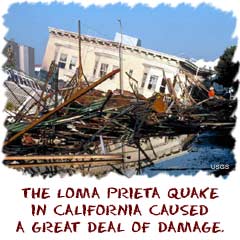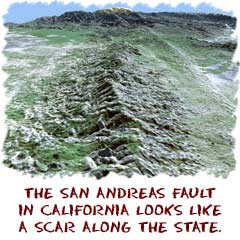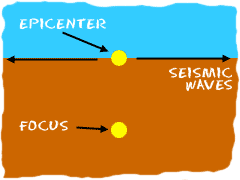When The Ground Moves
 Rumble rumble rumble! Have you ever been in an earthquake? Some people go through them all the time. In California there are dozens every day but they are usually very small. You tend to remember the big ones. Earthquakes are the breaking and cracking of the rocks inside the continental plates. The breaks happen after stress has built up in the surrounding area. There are usually very few or no quakes when the plates move slowly. When there is a fast movement of the plate, there is a snap (like breaking a cracker).
Rumble rumble rumble! Have you ever been in an earthquake? Some people go through them all the time. In California there are dozens every day but they are usually very small. You tend to remember the big ones. Earthquakes are the breaking and cracking of the rocks inside the continental plates. The breaks happen after stress has built up in the surrounding area. There are usually very few or no quakes when the plates move slowly. When there is a fast movement of the plate, there is a snap (like breaking a cracker).
Changing The Landscape
 More than buildings collapse when an earthquake hits. The land itself is totally changed. You can see scars across the landscape. Those scars appear when one block of land has moved compared to another. Roads often change their placement. They either become uneven or just crack. Streams can also change course. Sometimes rocks can fall and block the stream. Other times, the land is even lowered in certain areas. When it's lower, it's easier for the water to flow in the new direction.
More than buildings collapse when an earthquake hits. The land itself is totally changed. You can see scars across the landscape. Those scars appear when one block of land has moved compared to another. Roads often change their placement. They either become uneven or just crack. Streams can also change course. Sometimes rocks can fall and block the stream. Other times, the land is even lowered in certain areas. When it's lower, it's easier for the water to flow in the new direction.
Changes also happen on larger scales. Fault valleys and troughs can be created. These areas have large amounts of fracturing (the fracture zone is large). After the land has opened up, weather begins to act on the area and erosion follows. Slowly, new valleys are created.
Waves Across The Land
You might think, "If it only happens in one place, why can you feel them hundreds of miles away?" The crack happens where the quake starts. Ripples then move out in waves across the plate. Those waves are called seismic waves. Those waves shake everyone up within a specific area. When scientists analyze an earthquake they look at several parts. They find out where the focus is. The focus is the exact point where the earthquake started. It is usually many miles/kilometers below the surface of the Earth. Scientists also look to see where the epicenter was. The epicenter is the point on the surface directly above the focus. When you think about the epicenter, try to remember there is actually a crack in the crust many kilometers below.
When scientists analyze an earthquake they look at several parts. They find out where the focus is. The focus is the exact point where the earthquake started. It is usually many miles/kilometers below the surface of the Earth. Scientists also look to see where the epicenter was. The epicenter is the point on the surface directly above the focus. When you think about the epicenter, try to remember there is actually a crack in the crust many kilometers below.
Built For Quakes
After an earthquake, you can turn on the television and see all sorts of footage showing buildings that didn't quite survive. Buildings are built for up and down forces. If you jump on your floor a bunch of times your house will stay up. Earthquakes have forces that move side to side. Houses aren't built for that direction of energy. When the Earth moves side to side, the house can't wobble and it snaps. The walls collapse and roof falls in. Really tall skyscrapers are well designed for earthquakes. They are built to withstand strong winds. When strong winds happen, they can move side to side and sway if needed.
Or search the sites for a specific topic.
- Overview
- Composition
- Magnetic Field
- Structure
- Rock Types
- Tectonics
- Faulting
- Earthquakes
- Volcanoes
- More Topics

Earthquakes – Shock Waves (USGS Video)

Useful Reference Materials
Encyclopedia.com:http://www.encyclopedia.com/topic/earthquake.aspx
Wikipedia:
http://en.wikipedia.org/wiki/Earthquake
Encyclopædia Britannica:
http://www.britannica.com/EBchecked/topic/176199/earthquake





